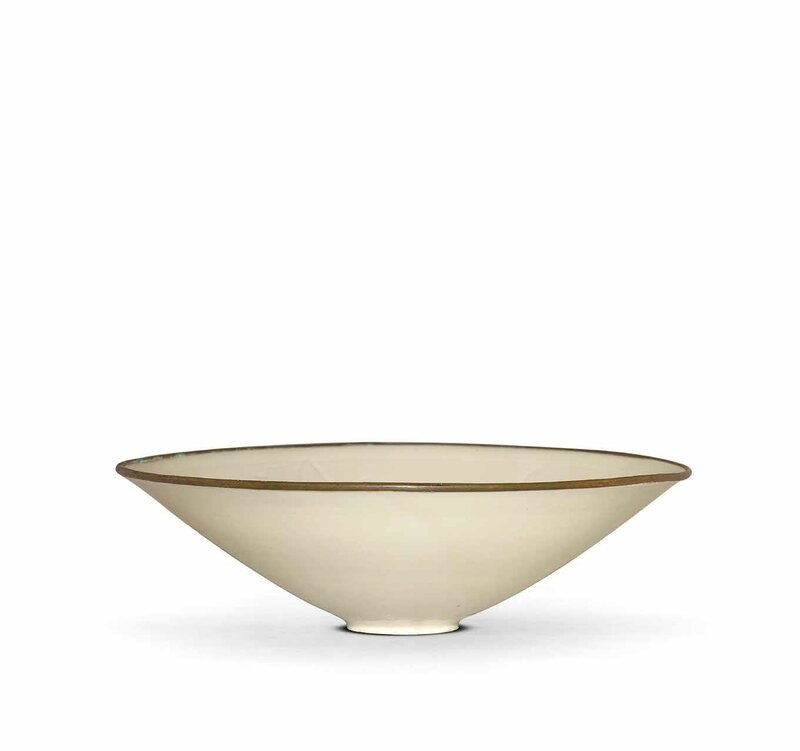A rare and superbly carved Ding ‘lotus’ conical bowl, Northern Song dynasty, 11th-12th century
Lot 3016. A rare and superbly carved Ding ‘lotus’ conical bowl, Northern Song dynasty, 11th-12th century; 8 1/4 in. (21 cm.) diam. Estimate HK$3,000,000 – HK$5,000,000 ($388,148 - $646,914). Price Realized HK$7,480,000 ($967,783). Photo Christie's Image Ltd 2016.
The bowl is delicately potted with straight flaring sides, supported on a short cylindrical foot. The interior is finely carved with meandering stems of lotus blooms and a lotus leaf, covered overall in a transparent ivory-tinged glaze pooling in the recesses. The rim is bound with a metal band.
Provenance: The Hosokawa Family Collection until the 1990s
Kochukyo, Tokyo
Property from the Linyushanren Collection
This superb Ding bowl is from the Linyushanren Collection. Linyushanren is the hall name of a private Japanese connoisseur who has collected Chinese ceramics since the 1970s, focusing almost entirely on Song ceramics after 1996. Over the past two decades, the Linyushanren Collection has become one of the most comprehensive collections of Song ceramics in private hands. The collection stands as a testament to the diligence and fine taste of the collector.
The present bowl was previously owned by the renowned Hosokawa clan. Spanning over 700 years, the Hosokawa clan has played a crucial role in the political and cultural development of Japanese society. The Hosokawa family has long been celebrated as great connoisseurs and patrons of art, especially for tea ceremony related objects. The 16th head of the clan, Hosokawa Moritatsu (1883-1970) was a keen collector of Chinese art and founded the Eisei Bunko Museum in 1950.
Mr. Moritatsu Hosokawa was tireless in his quest for the most sophisticated art works and did not confine his search within Japan. He travelled extensively across Europe and America in order to meet prominent dealers and collector such as C.T. Loo, George Eumorphopolous and R.L. Hobson. Legend has it that he frequently competed with Sir Percival David over the very best Chinese works of art.
Literature: Japanese Ceramics Society, Exhibition of the Masterpieces of Song Ceramics: Ding and Cizhou Wares, Tokyo, 1962, no. 17
Kochukyo, Soji (Song Ceramics), Tokyo, 1998, no. 5
Christie's, The Classical Age of Chinese Ceramics: An Exhibition of Song Treasures from the Linyushanren Collection,Hong Kong, 2012, pp. 28-29, no. 4
Exhibited: Japanese Ceramics Society, Exhibition of the Masterpieces of Song Ceramics: Ding and Cizhou Wares, Nihonbashi Shirokiya,
Tokyo, 7-12 December 1962, Catalogue, no. 17
Kochukyo, Soji (Song Ceramics), Tokyo, 2-4 October 1998, Catalogue, no. 5
Christie's, The Classical Age of Chinese Ceramics: An Exhibition of Song Treasures from the Linyushanren Collection, Hong Kong, 22-27 November 2012; New York, 15-20 March 2013; London, 10-14 May 2013, Catalogue, no. 4
The present bowl as illustrated in Exhibition of the Masterpieces of Song Ceramics: Ding and Cizhou Wares, Tokyo, 1962, no. 17
Notes: The simple and elegant form of the present conical bowl represents the quintessential aesthetics of the Song period. Conical bowls of this type were used in Song dynasty tea-making games that were judged largely by how long the froth lasted. The conical shape is particularly suitable for this game since a water mark can be better observed on the straight flaring wall. It was possibly also for this reason that the conical bowl form became a popular shape among major Northern and Southern kilns. In Ding kilns, conical bowls were applied with three types of decoration: black/brown glaze; moulded designs; and carved designs. The first type is comprised of a small number of highly prestigious examples, known as black Ding and purple Ding in traditional literature, including a ‘partridge feather’ black Ding conical bowl in the Linyushanren Collection, previously sold at Christie’s Hong Kong, One Man’s Vision: Important Chinese Art from The Manno Art Museum, 28 October 2002, lot 515. The second group is of slightly later dating; including examples with moulded pomegranate design, chrysanthemum design, and various bird designs, see Tsai Meifen, Decorated Porcelains of Dingzhou: White Ding Wares from the collection of the National Palace Museum, Taipei, 2014, nos. II-98, II-100-102, and II-121-124.
The carved examples such as the present bowl are also rare as the carvings could not be easily executed on thin walls of the conical shape. A similar Ding conical bowl with daylily design but of smaller size is in the collection of the Taipei Palace Museum, illustrated in Empty Vessels, Replenished Minds: The Culture, Practice, and Art of Tea, Taipei, 2002, p. 42, no. 18. For two examples with carved peony and pomegranate designs, please see Tsai Meifen, Decorated Porcelains of Dingzhou: White Ding Wares from the collection of the National Palace Museum, Taipei, 2014, nos. II-25, 26. Another prominent carved design on Ding conical bowl is spiralling linear pattern, resembling a stylised lotus leaf. One Ding conical bowl with this design was in the Qing Court Collection and included in one of Qianlong Emperor’s ceramic albums, Jingtao yungu (Refined Ceramics of Collected Antiquity), and illustrated in Obtaining Refined Enjoyment: The Qianlong Emperor’s Taste in Ceramics, Taipei, 2011, pp. 234-235, no. 109.
Lotus is a popular decorative theme on Ding wares, for its quality of ‘rising from the mud unsullied, bathed by clear waves but not seductive’, as expressed in a famous poem, Passion for the Lotus by Song scholar-official Zhou Dunyi (1017- 1073). Another symbolic meaning of Lotus is derived from its phonetic similarity with the phrase ‘incorruptible’ in Chinese. Therefore, vessels decorated with lotus were particularly suitable for the scholarofficial class.
Christie's. 30 YEARS: THE SALE, 30 May 2016, Convention Hall

/https%3A%2F%2Fprofilepics.canalblog.com%2Fprofilepics%2F1%2F0%2F100183.jpg)
/https%3A%2F%2Fstorage.canalblog.com%2F03%2F02%2F119589%2F96711876_o.jpg)
/https%3A%2F%2Fstorage.canalblog.com%2F11%2F31%2F119589%2F94773502_o.jpg)
/https%3A%2F%2Fstorage.canalblog.com%2F20%2F83%2F119589%2F94772815_o.jpg)
/https%3A%2F%2Fstorage.canalblog.com%2F26%2F72%2F119589%2F75604929_o.jpg)
/https%3A%2F%2Fstorage.canalblog.com%2F59%2F60%2F119589%2F26458628_o.jpg)






/image%2F1371349%2F20240411%2Fob_4a5248_2024-nyr-22642-0913-000-a-longquan-cel.jpg)
/image%2F1371349%2F20240410%2Fob_b0ef72_2024-nyr-22642-0908-000-a-carved-ding.jpg)
/http%3A%2F%2Fstorage.canalblog.com%2F29%2F47%2F119589%2F129819867_o.jpg)
/http%3A%2F%2Fstorage.canalblog.com%2F93%2F57%2F119589%2F129818552_o.jpg)